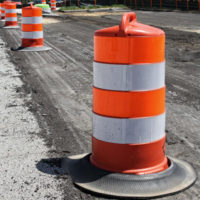The Importance of Improving Work Zone Safety
August 21, 2019 According to the Federal Highway Administration (FHWA), in the last five years more than 4,400 people died – and at least 200,000 others were injured – in work zone crashes across the country. Workers, drivers, and passengers alike face a variety of work zone-associated hazards, though the FHWA reports drivers as the most frequent fatalities.
According to the Federal Highway Administration (FHWA), in the last five years more than 4,400 people died – and at least 200,000 others were injured – in work zone crashes across the country. Workers, drivers, and passengers alike face a variety of work zone-associated hazards, though the FHWA reports drivers as the most frequent fatalities.
Although every state (except Wyoming) enforces increased penalties for traffic violations (like speeding) in construction work zones, still too many injuries and deaths occur. By taking a few simple steps, we can each do our part to ensure fewer work zone accidents.
Work Zone Crash Data
The FHWA reports that 85% of all fatal work zone accidents involve drivers or passengers. Here are some other well-documented features of fatal work zone accidents:
- Most fatalities occur on roads with speed limits greater than 50 mph;
- The majority of fatalities involve working-age adults;
- Rear-end crashes (when a vehicle collides with a stopped or slowed vehicle’s rear) are the most common type of work zone accidents, and;
- Fatal crashes occur more frequently in the summer and fall
Safe Stopping Distances
Different kinds of vehicles (as well as a variety of driving conditions, such as inclement weather) require different safe stopping distances in order to avoid crashes from occurring. Here is some useful, lifesaving information on safe stopping distances (for motor vehicles traveling at 50 mph) direct from the FHWA:
- When traveling at 50 mph on a dry roadway, a motor vehicle needs approximately 300 ft of space between it and the next car or truck to be able to come to a safe stop;
- Wet roadways require a minimum of 400 feet as a safe stopping distance, and:
- On icy roadways, motor vehicles require at least 1,250 feet of space
Weighted trucks require much more space to come to a safe stop than lighter vehicles. For example, an 80,000-pound tractor-trailer needs nearly 50% more stopping distance (in any driving condition) than a passenger vehicle. Avoiding tailgating and/or traveling too closely behind other vehicles can help prevent deadly work zone accidents from happening.
How Many Workers Are Injured or Killed in Work Zone Accidents?
The Bureau of Labor Statistics (BLS) reports that more than 120 workers are killed in road construction site (e.g. active construction work zone) accidents every year. Pennsylvania is one of four states (Texas, Florida, and California) to have the highest rate of fatal work zone injuries. For example, while 17 fatal occupational injuries at roadwork zones occurred during a 4-year period across the entire state of New York, Pennsylvania had more than two-times that amount (38) in the same period.
Nearly one-half of the total worker fatalities in work zones result from workers being struck by vehicles or construction equipment. When it comes to the types of vehicles involved in these accidents, workers are most frequently struck by motor vehicles and dump trucks. Workers are more likely to be fatally injured in collisions with forward-moving motor vehicles, but when it comes to dump trucks, more than half the fatal accidents involve ones driving in reverse. Remember, work zone workers are vulnerable to injuries, so driving slowly and staying aware can help save someone’s life.
More Work Zone Safety Tips From the FHWA
Staying alert behind the wheel is one of the best ways to avoid preventable accidents. There are a variety of different deadly driving distractions, but some of the most common ones are using a cell phone, eating, drinking, changing the radio or GPS settings, and any other activity that takes a driver’s attention off the road.
Drivers in work zones should always have their headlights on, and should observe all posted signs, speed limits, and warnings. The FHWA wants drivers to remember to “listen to the signs”, which includes keeping an eye out for brake lights on vehicles ahead and driving defensively (e.g. watching traffic and being prepared to react quickly).
It is also critical to remember that in work zones, the unexpected can always happen. Make sure to follow directions from flaggers, and be prepared for vehicles slowing down, changing lanes, and stopping unexpectedly. The FHWA also warns drivers to look out for work vehicles, workers, and equipment entering the driver’s lane without warning.
Even when people take precautions and drive responsibly, catastrophic accidents still happen. If you were in a work zone collision and have questions about filing a claim, someone at our firm can help. Please contact a representative directly.
Philadelphia Personal Injury Lawyers at Galfand Berger, LLP Represent Victims of Motor Vehicle Accidents
If you were injured in a work zone crash, please contact our Philadelphia personal injury lawyers. With offices located in Philadelphia, Bethlehem, Lancaster, and Reading Galfand Berger serve clients throughout Pennsylvania and New Jersey. To schedule a consultation, call us at 800-222-8792 or complete our online contact form.
 Google Screened
Google Screened
